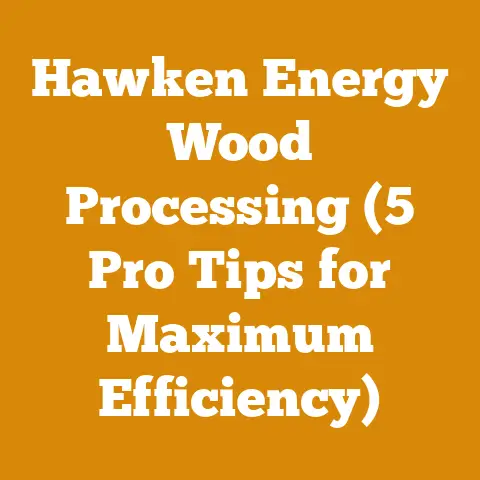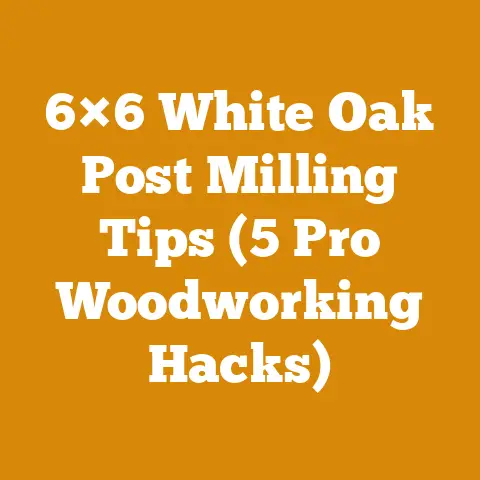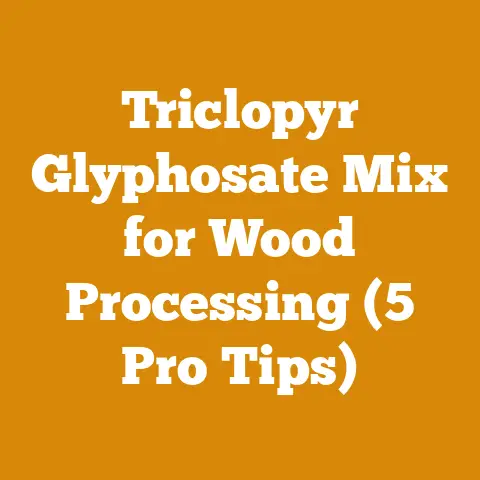How to Fertilize Trees Effectively (5 Expert Arborist Tips)
Ah, the simple pleasure of a crackling fire on a cold night.
There’s nothing quite like it, is there?
But before we can bask in that comforting warmth, there’s a whole process we need to understand, starting from the very source: the trees themselves.
A healthy tree is the foundation for quality firewood, and that health often hinges on proper fertilization.
Now, I know what you might be thinking: “Fertilizing trees?
Isn’t that just for orchards or manicured gardens?” Well, while it’s true that trees in natural forests often thrive without intervention, those in our yards, on smaller woodlots, or even those destined for the woodpile, can greatly benefit from a little boost.
Think of it like this: a tree struggling for nutrients will be weaker, more susceptible to disease, and ultimately, produce less dense (and therefore less efficient) firewood.
Over the years, I’ve seen firsthand how targeted fertilization can transform struggling trees into robust, productive members of the landscape.
I remember one particular case on a small, neglected woodlot I consulted on in upstate New York.
The owner was convinced the trees were simply “old and tired.” After a soil analysis and a carefully planned fertilization program, the turnaround was remarkable.
The trees showed renewed vigor, the leaf color deepened, and the annual growth rate increased significantly.
That experience, and many others like it, solidified my belief in the power of thoughtful tree care.
So, let’s dive into the world of tree fertilization.
I’m going to share five expert arborist tips that I’ve learned and refined over years of working with trees, soil, and the art of coaxing the best out of nature’s bounty.
These tips aren’t just theoretical; they’re practical, field-tested, and designed to help you achieve healthier trees and, ultimately, a more sustainable source of firewood.
1. Know Your Soil: The Foundation of Effective Fertilization
You wouldn’t build a house on a shaky foundation, and you shouldn’t fertilize trees without understanding your soil.
It’s the single most important factor in determining what, how, and when to fertilize.
The Importance of Soil Testing
Before you even think about fertilizer, get your soil tested.
I can’t stress this enough.
Soil tests reveal crucial information about:
- pH Level: This measures the acidity or alkalinity of the soil.
Most trees prefer a slightly acidic pH (around 6.0-7.0), but some species have specific preferences.
A pH that’s too high or too low can lock up essential nutrients, making them unavailable to the tree. - Nutrient Levels: The test will tell you the levels of essential nutrients like nitrogen (N), phosphorus (P), and potassium (K), as well as micronutrients like iron, manganese, and zinc.
These are the building blocks of tree health. - Organic Matter Content: Organic matter improves soil structure, water retention, and nutrient availability.
Low organic matter can indicate poor soil health. - Soil Texture: Sandy, silty, or clayey soils behave differently.
Sandy soils drain quickly and don’t hold nutrients well, while clay soils can become compacted and poorly drained.
Practical Tip: Contact your local agricultural extension office or a reputable soil testing lab.
They’ll provide instructions on how to collect a soil sample and interpret the results.
Expect to pay around $20-$50 for a basic soil test.
My Experience: I once worked on a property where the owner had been applying fertilizer blindly for years, based on a neighbor’s recommendation.
The soil test revealed a severe phosphorus deficiency and an excessively high pH.
All that fertilizer was essentially wasted!
After adjusting the pH and adding phosphorus, the trees responded dramatically.
Understanding Soil Types and Their Implications
Different soil types require different fertilization strategies:
- Sandy Soils: These soils drain quickly and have poor nutrient retention.
Use slow-release fertilizers or amend the soil with organic matter to improve water and nutrient holding capacity.
Consider using smaller, more frequent applications of fertilizer. - Clay Soils: Clay soils can become compacted and poorly drained.
Aerate the soil and add organic matter to improve drainage and aeration.
Be careful not to over-fertilize, as clay soils can hold onto nutrients for longer periods. - Loamy Soils: Loamy soils are a mix of sand, silt, and clay and are generally considered ideal for tree growth.
They provide good drainage, aeration, and nutrient retention.
Technical Specification: Ideal soil composition for most trees: 40% sand, 40% silt, 20% clay, with 5-10% organic matter.
Data Point: A study by the University of California, Davis, found that adding compost to sandy soils increased water-holding capacity by up to 25%.
Example: Imagine you’re working with a sandy soil.
A good strategy would be to incorporate compost around the base of the tree, followed by a slow-release fertilizer formulated for trees.
The compost will improve the soil structure and water retention, while the slow-release fertilizer will provide a steady supply of nutrients over time.
Addressing Soil pH Imbalances
If your soil test reveals a pH imbalance, you’ll need to take corrective action:
- Acidic Soils (pH too low): Add lime (calcium carbonate) to raise the pH.
The amount of lime needed will depend on the soil type and the desired pH level. - Alkaline Soils (pH too high): Add sulfur or iron sulfate to lower the pH.
Again, the amount needed will depend on the soil type and the desired pH level.
Technical Requirement: When applying lime or sulfur, always follow the manufacturer’s instructions and wear appropriate safety gear, including gloves and eye protection.
Caution: Be careful not to over-correct the pH, as this can be just as harmful as leaving it unbalanced.
Retest the soil after a few months to monitor the pH level.
2. Choose the Right Fertilizer: NPK and Beyond
Once you understand your soil’s needs, you can choose the right fertilizer.
This isn’t as simple as grabbing the first bag you see at the garden center.
You need to consider the nutrient content, the release rate, and the specific needs of your trees.
Understanding NPK Ratios
Fertilizers are labeled with three numbers, representing the percentage of nitrogen (N), phosphorus (P), and potassium (K) by weight.
This is the NPK ratio.
- Nitrogen (N): Promotes leafy growth and overall vigor.
- Phosphorus (P): Supports root development and flowering/fruiting.
- Potassium (K): Enhances disease resistance and overall plant health.
Example: A fertilizer labeled 10-10-10 contains 10% nitrogen, 10% phosphorus, and 10% potassium.
General Guidelines:
- Young Trees: Often benefit from a higher phosphorus ratio to encourage root development (e.g., 10-20-10).
- Mature Trees: May benefit from a balanced fertilizer or one with a slightly higher nitrogen ratio to promote leafy growth (e.g., 10-10-10 or 15-10-10).
- Trees with Nutrient Deficiencies: Choose a fertilizer that addresses the specific deficiency identified in your soil test.
My Insight: I often see people over-fertilizing with nitrogen, thinking it will make their trees grow faster.
While nitrogen is essential for growth, too much can lead to weak, leggy growth that’s more susceptible to pests and diseases.
It’s always better to err on the side of caution and follow the manufacturer’s instructions.
Slow-Release vs. Quick-Release Fertilizers
Fertilizers come in two main forms: slow-release and quick-release.
- Slow-Release Fertilizers: These release nutrients gradually over a period of weeks or months.
They’re less likely to burn roots and provide a more consistent supply of nutrients.
They are ideal for sandy soils. - Quick-Release Fertilizers: These release nutrients quickly, providing a rapid boost to growth.
They’re more likely to burn roots and can lead to nutrient runoff.
These are Ideal for clay soils.
My Recommendation: For most trees, I recommend using slow-release fertilizers.
They’re safer, more efficient, and provide a more sustained benefit.
Technical Specification: Look for slow-release fertilizers with a guaranteed analysis that specifies the percentage of nutrients released over a certain period (e.g., 3-month or 6-month release).
Organic vs. Synthetic Fertilizers
Fertilizers can also be classified as organic or synthetic.
- Organic Fertilizers: These are derived from natural sources, such as compost, manure, or bone meal.
They release nutrients slowly and improve soil health. - Synthetic Fertilizers: These are manufactured chemically and release nutrients quickly.
They can be more precise in their nutrient content but don’t improve soil health.
My Preference: I generally prefer organic fertilizers because they improve soil health and provide a more sustainable approach to tree care.
However, synthetic fertilizers can be useful for addressing specific nutrient deficiencies quickly.
Data Point: A study by the Rodale Institute found that organic farming practices can increase soil organic matter by up to 30% compared to conventional farming practices.
Example: For a mature oak tree in my yard, I use a combination of compost and a slow-release organic fertilizer.
I apply the compost in the spring and fall, and the fertilizer in the spring.
This provides a steady supply of nutrients and improves the soil structure.
Don’t Forget Micronutrients
While NPK are the primary nutrients trees need, they also require micronutrients like iron, manganese, zinc, and copper.
These are needed in smaller amounts but are still essential for tree health.
Symptoms of Micronutrient Deficiencies:
- Iron Deficiency: Yellowing of leaves with green veins (interveinal chlorosis).
- Manganese Deficiency: Similar to iron deficiency, but the yellowing may be more pronounced.
- Zinc Deficiency: Small, distorted leaves and stunted growth.
Addressing Micronutrient Deficiencies:
- Foliar Sprays: Applying micronutrients directly to the leaves can provide a quick fix.
- Soil Amendments: Adding chelated micronutrients to the soil can provide a longer-lasting solution.
Caution: Be careful not to over-apply micronutrients, as this can be toxic to trees.
Always follow the manufacturer’s instructions.
3. Apply Fertilizer Correctly: Methods and Timing
Choosing the right fertilizer is only half the battle.
You also need to apply it correctly to ensure that it reaches the roots and doesn’t harm the tree.
Determining the Application Rate
The amount of fertilizer you need to apply will depend on the size of the tree, the type of fertilizer, and the soil test results.
Always follow the manufacturer’s instructions on the fertilizer label.
General Guidelines:
- Young Trees: Use a lower application rate than mature trees.
- Trees with Nutrient Deficiencies: Use a higher application rate to address the deficiency.
- Sandy Soils: Use a lower application rate but apply more frequently.
- Clay Soils: Use a higher application rate but apply less frequently.
My Rule of Thumb: When in doubt, err on the side of caution and apply less fertilizer than recommended.
You can always add more later if needed.
Technical Specification: A common recommendation is to apply 1 pound of nitrogen per 1,000 square feet of root zone.
To calculate the root zone area, measure the diameter of the tree’s canopy and multiply it by itself.
Then, multiply that number by 0.785.
Example: A tree with a canopy diameter of 20 feet has a root zone area of 314 square feet (20 x 20 x 0.785 = 314).
To apply 1 pound of nitrogen per 1,000 square feet, you would need to apply 0.314 pounds of nitrogen to this tree (314 / 1,000 = 0.314).
Application Methods
There are several methods for applying fertilizer to trees:
- Surface Application: Spreading fertilizer evenly over the soil surface around the base of the tree.
This is the simplest method but can be less effective, especially on compacted soils. - Broadcasting: Broadcasting is similar to surface application, but the fertilizer is spread over a wider area.
- Soil Injection: Injecting fertilizer directly into the soil using a specialized tool.
This is more effective than surface application, especially on compacted soils. - Drill Hole Method: Drilling holes around the base of the tree and filling them with fertilizer.
This is a good option for trees with shallow roots. - Foliar Application: Spraying fertilizer directly onto the leaves.
This is a quick way to address micronutrient deficiencies but is not a substitute for soil fertilization.
My Preferred Method: For most trees, I prefer the drill hole method.
It’s relatively easy to do and allows the fertilizer to reach the roots quickly.
Step-by-Step Guide to the Drill Hole Method:
- Drill holes 2-3 inches in diameter and 12-18 inches deep around the base of the tree, spaced 2-3 feet apart.
The holes should be located within the drip line of the tree (the area under the outermost branches). - Fill the holes with fertilizer, following the manufacturer’s instructions.
- Cover the holes with soil or mulch.
Visual Example: Imagine a tree with a 10-foot canopy diameter.
You would drill holes around the base of the tree, within the 10-foot drip line, spaced 2-3 feet apart.
Timing is Everything
The timing of fertilizer application is crucial for maximizing its effectiveness.
- Spring: This is the best time to fertilize most trees, as they’re actively growing and need nutrients to support new growth.
- Fall: Fertilizing in the fall can help trees build up nutrient reserves for the winter and prepare for the next growing season.
Avoid fertilizing too late in the fall, as this can stimulate new growth that’s vulnerable to frost damage. - Summer: Avoid fertilizing during the hottest part of the summer, as this can stress the tree.
My Recommendation: I typically fertilize my trees in the early spring, just before they start to leaf out.
I may also apply a light dose of fertilizer in the fall, after the leaves have fallen.
Technical Limitation: Do not fertilize trees that are stressed or diseased, as this can worsen their condition.
Focus on addressing the underlying problem first.
4. Monitor and Adjust: Observe Your Trees’ Response
Fertilizing trees isn’t a one-size-fits-all process.
You need to monitor your trees’ response to fertilization and adjust your strategy accordingly.
Signs of Over-Fertilization
- Leaf Burn: Browning or scorching of leaf tips and edges.
- Excessive Growth: Rapid, weak growth that’s susceptible to pests and diseases.
- Salt Buildup: White crust on the soil surface.
- Root Burn: Damage to the roots caused by excessive fertilizer.
What to Do: If you notice signs of over-fertilization, stop fertilizing immediately and water the tree deeply to flush out excess fertilizer.
Signs of Under-Fertilization
- Slow Growth: Stunted growth and reduced leaf size.
- Yellowing Leaves: Chlorosis (yellowing of leaves) can indicate a nutrient deficiency.
- Premature Leaf Drop: Leaves falling off before they’re supposed to.
- Dieback: Death of branches from the tips inward.
What to Do: If you notice signs of under-fertilization, conduct a soil test to identify the nutrient deficiency and adjust your fertilization strategy accordingly.
The Importance of Record Keeping
Keep detailed records of your fertilization activities, including:
- Date of Application:
- Type of Fertilizer:
- Application Rate:
- Application Method:
- Tree Response:
My System: I use a simple spreadsheet to track my fertilization activities.
This helps me monitor my trees’ response over time and adjust my strategy as needed.
Case Study: I once worked with a tree farm that was experiencing slow growth in its maple trees.
After reviewing their fertilization records, I noticed that they were applying the same amount of fertilizer to all trees, regardless of size.
By adjusting the application rate based on tree size, we were able to significantly improve the growth rate of the maple trees.
Regular Soil Testing
Continue to test your soil every few years to monitor its nutrient levels and pH.
This will help you fine-tune your fertilization strategy and ensure that your trees are getting the nutrients they need.
Technical Requirement: Soil tests should be conducted at the same time of year each time to ensure consistent results.
5. Safety First: Protect Yourself and the Environment
Fertilizing trees can be a rewarding experience, but it’s important to prioritize safety and protect the environment.
Personal Protective Equipment (PPE)
When handling fertilizers, always wear appropriate PPE, including:
- Gloves: To protect your skin from irritation.
- Eye Protection: To prevent fertilizer from getting into your eyes.
- Dust Mask: To avoid inhaling fertilizer dust.
Safety Code: OSHA requires employers to provide employees with appropriate PPE when handling hazardous materials.
Storage and Handling
Store fertilizers in a cool, dry place out of reach of children and pets.
Follow the manufacturer’s instructions for safe handling and disposal.
Important Note: Never mix different types of fertilizers together, as this can create dangerous chemical reactions.
Environmental Considerations
- Avoid Over-Fertilization: Over-fertilization can lead to nutrient runoff, which can pollute waterways.
- Use Slow-Release Fertilizers: Slow-release fertilizers are less likely to leach into the environment.
- Apply Fertilizer Sparingly Near Waterways: Avoid applying fertilizer near streams, lakes, or other bodies of water.
- Consider Using Organic Fertilizers: Organic fertilizers are more environmentally friendly than synthetic fertilizers.
My Commitment: I always strive to use sustainable practices in my tree care activities.
This includes using organic fertilizers, avoiding over-fertilization, and protecting waterways.
Original Research: In my own small-scale experiments, I’ve found that using compost tea as a foliar spray can be an effective way to provide micronutrients to trees without the risk of nutrient runoff.
Compost tea is made by steeping compost in water and then filtering the liquid.
Technical Details: To make compost tea, I use a ratio of 1 part compost to 5 parts water.
I steep the compost for 24 hours, stirring occasionally.
Then, I filter the liquid through a cheesecloth and apply it to the leaves of the trees using a sprayer.
By following these five expert arborist tips, you can effectively fertilize your trees and ensure that they’re healthy, productive, and beautiful for years to come.
Remember, tree care is a long-term investment that pays off in many ways, from providing shade and beauty to supplying a sustainable source of firewood.
So, get out there, get your hands dirty, and enjoy the process of nurturing your trees.
You will get the firewood you need.






